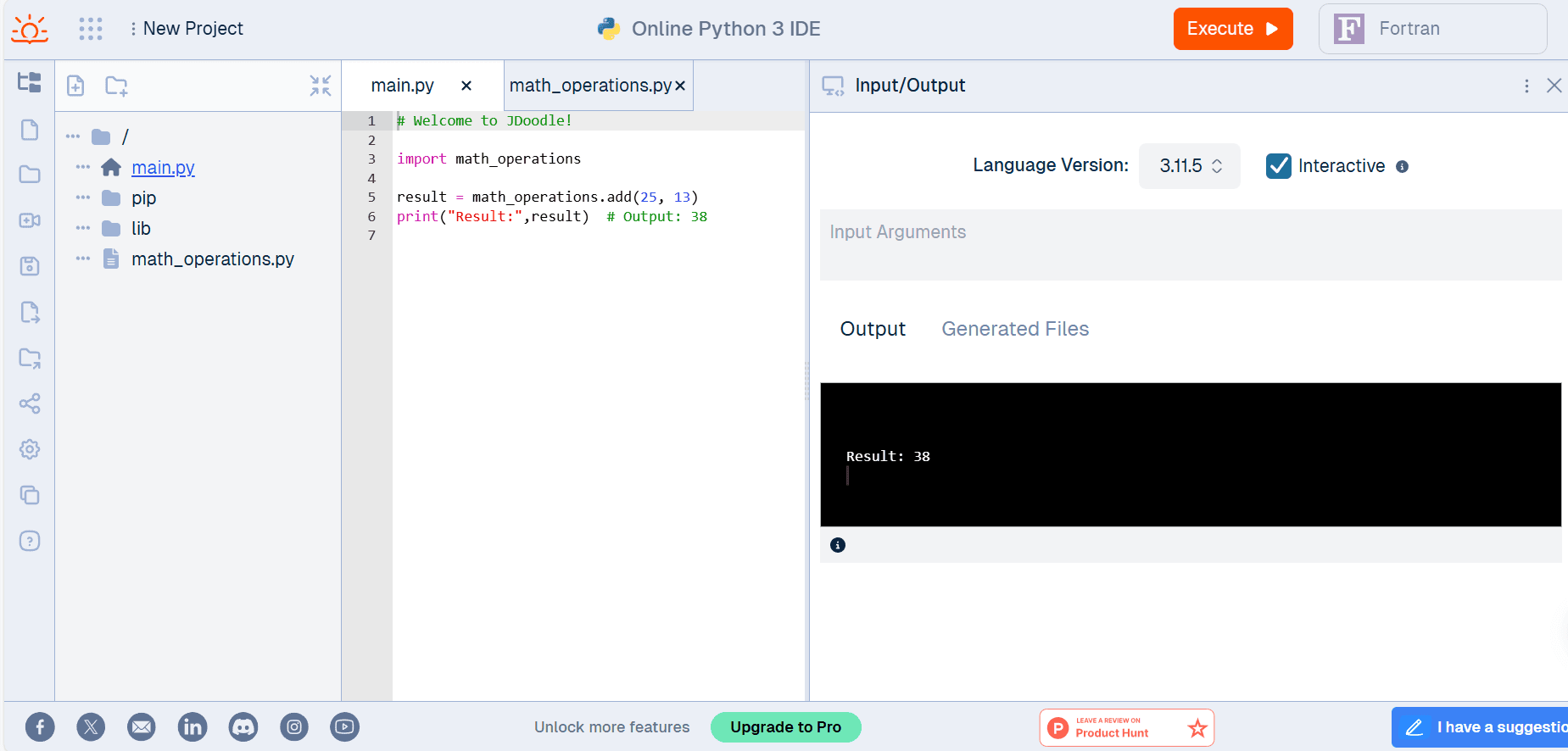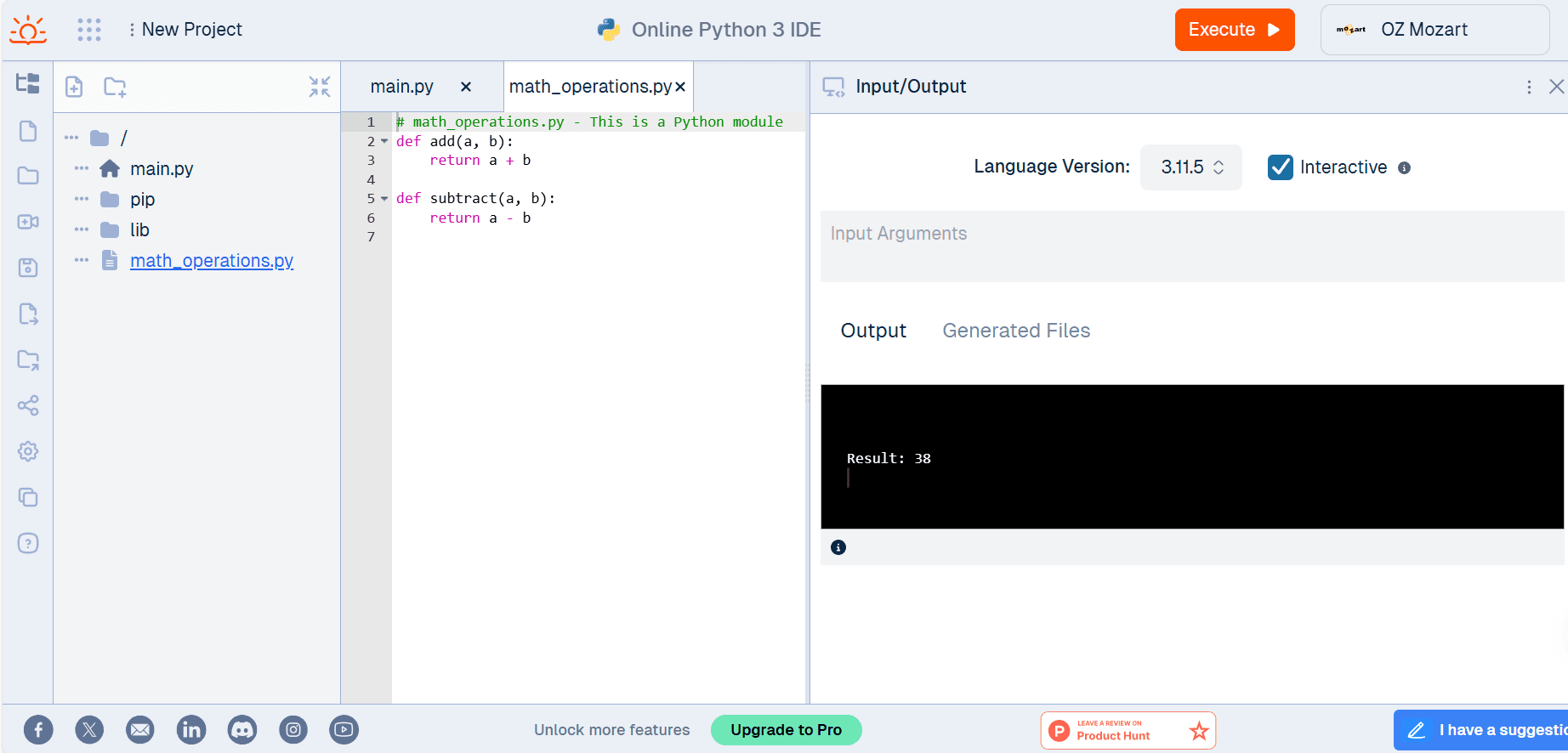Are you tired of heavy lines of code and many Python files in your Python projects? Then modules and packages are your answer. They can make your code organized and efficient. These will divide the work into smaller parts and make it more organized and easier to maintain. If you’re new to Python or want to improve, learn about modules and packages.
What are Python modules?
A Python module is a file with Python code. It includes functions, classes, and variables. Modules group related functions. They make code easier to understand, maintain, and reuse.
Here’s a tutorial on how to add Python modules and packages on JDoodle: link.
Real-world example
Consider a toolbox as a module. With the help of a toolbox, we can keep all our tools in one place in an organized manner. Similarly, a module has all related functions and classes in it. When a tool is necessary, we know exactly where to find it.
Example:
Create a module with math_operations.py as the file name.
# math_operations.py - This is a Python module
def add(a, b):
return a + b
def subtract(a, b):
return a - b
Using this module( math_operations.py) in another Python file:
import math_operations
result = math_operations.add(25, 13)
print(result) # Output: 38
This approach saves time and reduces errors by avoiding code duplication.
Note: The * in the import statement imports all names from a module to the current namespace.
from module_name import *

Code for main.py file

What are Python packages?
A Python package is a collection of modules in a directory. That directory must contain a file called init.py. This file indicates that developers should treat the directory as a package. Packages help organize your code. They make it easier to manage and maintain. They also let you share your code with others.
Real-world example
Consider the library as a package. In the library, librarians place every book in a separate row based on its category or branch. Keeping things organized allows for easy access to books.
Example:
Consider the name of the package is calculator:
calculator/
__init__.py
addition.py
subtraction.py
To use the calculator package:
from calculator import addition, subtraction
result = addition.add(10, 5)
print(result) # Output: 15
In the above example, the calculator package has two modules, addition and subtraction. We can import and use them in the program wherever necessary.
Uses of modules and packages
- Code Reusability: Write your code once using modules and packages. We can reuse it the same in various projects. This saves time in reduces redundancy in the work.
- Organization: They divide large programs into smaller parts, which helps them handle large projects easily. Keeping everything in one file can be confusing.
- Maintenance: Modules and packages are easier to maintain. We can update or fix one part of the code without affecting the entire project.
How to create a Python module
- Write the code: Create a new python(.py) file and write some functions or classes in it.
- Save the file: Save the file with the relevant file name. For example, if your module has math, name it math_operations.py.
- Import the module: In another Python file, use the import statement to import your module. Then, we can use its functions or classes.
With JDoodle, you can do it using multi-file IDE.
Example:
# math_operations.py
def multiply(a, b):
return a * b
# Using the module in another file
import math_operations
result = math_operations.multiply(4, 5)
print(result) # Output: 20
How to add a Python package
- Open the JDoodle IDE and click on add external library.
- Next, choose library of your choosing, make sure you are following the instructions as written.
- Click on add library and your project will have a library in the IDE.
Example
import pandas as pd
import numpy as np
# Generate fake student data
np.random.seed(42) # For reproducibility
students = [f"Student_{i}" for i in range(1, 11)]
scores = np.random.randint(50, 100, size=(10, 3)) # Scores for Math, Science, English
# Create a DataFrame
df = pd.DataFrame(scores, index=students, columns=["Math", "Science", "English"])
# Add an average score column
df["Average"] = df.mean(axis=1)
# Sort students by average score
df = df.sort_values(by="Average", ascending=False)
# Print top 3 students
print("Top 3 Students:")
print(df.head(3))
Key differences between Python modules and packages
| Characteristics | Python Module | Python Package |
|---|---|---|
| Definition | A single file with a .py extension | A directory with multiple .py files and init.py(optional in some environments). |
| Structure | Single file | Directory with subdirectories and files |
| Import | Imported directly (import module) | Imported using package name (from package import module) |
| Contents | Related functions, classes, and variables | Multiple modules and sub packages |
| Example | math_operations.py | calculator/ (with init.py, [addition.py](http://addition.py), [subtraction.py](http://subtraction.py)) |
| Purpose | Organize related code | Organize related modules and sub packages |
| File Count | Single file | Multiple files |
Note:
- Both Python packages and modules can contain multiple .py files. The key difference lies in how these files are organized and imported.
- init.py is optional: In Python 3.3 and laterinit.py is not strictly required to define a package, but it’s a good practice to include it for clarity and to control the package’s public interface.
Best practices for using modules and packages
- Naming convention: Use clear, simple names. This helps everyone understand the code.
- Avoid circular imports: Don’t let modules depend on each other. This prevents errors.
- Focus on modules: Each module should perform only one task. Split different tasks into separate modules.
- Document the code: Add comments and docstrings. It helps to understand.
Important Python modules and packages
Python has many modules and packages that save time. Here are some of them which are mostly used.
| Category | Module/Package | Description |
|---|---|---|
| Built-in Utilities | sys | Provides access to system-specific parameters and functions. |
| os | Interfaces with the operating system, allowing file and process management. | |
| shutil | Performs high-level file operations like copying and moving files. | |
| Data Handling | json | Parses and manipulates JSON data. |
| csv | Reads and writes CSV files. | |
| sqlite3 | Interfaces with SQLite databases. | |
| Mathematics & Statistics | math | Provides mathematical functions. |
| random | Generates random numbers and choices. | |
| statistics | Offers basic statistical operations. | |
| Data Science & Machine Learning | numpy | Supports numerical computations and arrays. |
| pandas | Handles data manipulation and analysis. | |
| matplotlib | Plots and visualizes data. | |
| scipy | Provides advanced scientific and numerical functions. | |
| scikit-learn | Implements machine learning algorithms. | |
| Web Development | flask | A lightweight web framework for building APIs and web applications. |
| django | A high-level web framework for building full-fledged applications. | |
| requests | Simplifies sending HTTP requests. | |
| Networking & Web Scraping | socket | Provides networking interfaces for socket programming. |
| http.client | Manages HTTP connections. | |
| beautifulsoup4 | Parses HTML/XML documents for web scraping. | |
| selenium | Automates browser interactions. | |
| Automation & Scripting | subprocess | Runs shell commands and manages processes. |
| time | Handles time-related functions. | |
| schedule | Automates task scheduling. | |
| Testing & Debugging | unittest | Provides a testing framework for Python. |
| pytest | A more flexible testing framework than unittest. | |
| logging | Records logs for debugging and error tracking. | |
| Cybersecurity & Cryptography | hashlib | Implements secure hashing algorithms. |
| cryptography | Provides cryptographic functions. | |
| ssl | Manages secure socket layer connections. | |
| GUI Development | tkinter | A built-in module for creating graphical user interfaces. |
| PyQt | A powerful GUI toolkit based on Qt. | |
| Kivy | Supports cross-platform mobile and desktop application development. | |
| Game Development | pygame | A library for game development. |
| Concurrency & Parallelism | threading | Implements multithreading for concurrent execution. |
| multiprocessing | Supports parallel processing across CPU cores. | |
| AI & Deep Learning | tensorflow | A deep learning framework by Google. |
| torch | A deep learning framework developed by Facebook (PyTorch). |
FAQs
Can I import multiple modules at once?
Yes, you can import many modules in one line using commas.
import math, os, sys
What’s the difference between a module and a package?
A module is a single file with Python code. A package is a directory with many modules and an init.py file.
How do I install external packages?
You can install external packages using pip, Python’s package install:
pip install package_name
Can I use a module from another directory?
Yes, you can. First, add the directory to your Python path using sys.path. If you’re in a package, then use relative imports.
import sys
sys.path.append('/path/to/your/module')
import your_module
Start organizing your Python projects today
Python packages and modules can organize long code easily. They break complex tasks into smaller, manageable parts. This makes your code easier to maintain and reuse. This makes the code cleaner and more efficient. These tools will save you time on organization. You will spend more time on creating software.
To practice and refine your skills, consider using JDoodle, a cutting-edge online coding platform. With JDoodle, you can:
- Write, compile, and execute Python code online
- Take advantage of AI-powered features, such as code optimization, debugging, and explanation
- Access a comprehensive platform for learning, teaching, practicing, and collaborating on programming projects
- Explore 88+ programming languages, including Python, Java, PHP, C, and C++
JDoodle is a convenient platform where you can use your Python skills to work with various modules and packages. Try JDoodle today and experience the ease of coding, learning, and collaboration.

